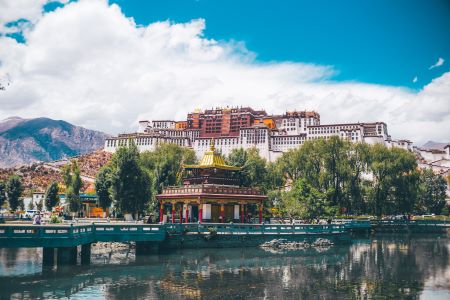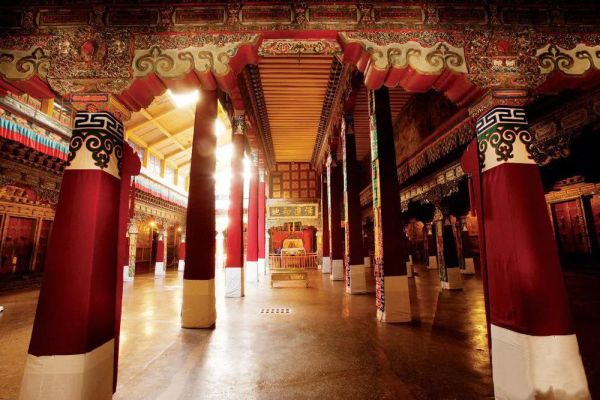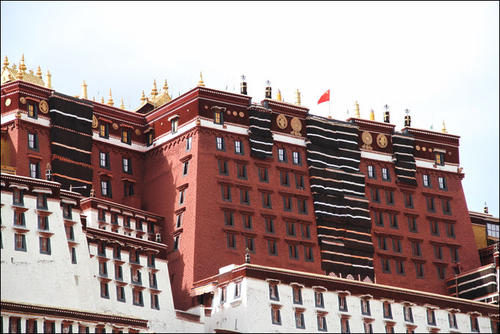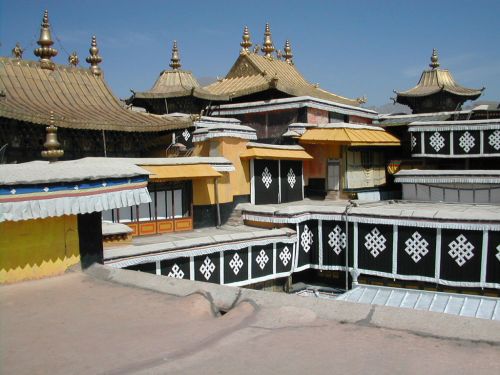Chinese Name: 布达拉宫 Pronunciation: Bù Dá Lā Gōng
Altitude: 3,700m
Building Time: 631
Suggested Visiting Hours: 2-3 Hours
Total Area: About 0.4 million square meters
Best Visiting Season: Spring, Summer and Autumn (March to October)
Address: No.35, Beijing Middle Road, Chengguan District, Lhasa
Building Function: To marry Princess Wencheng of the Tang Dynasty, Potala Palace was originally built by the Tibetan King Songtsan Gambo.
| Peak Season ( May– October) |
Low Season (November – April) |
|
| Adult | 200 yuan | 100 yuan |
| Child (under 1.2m (3.9 feet)) | Free | Free |
| Park Gate | Peak Season (April 1st to October 31st) |
Low Season (November 1st to March 31st) |
| Opening Hours | 9:30-15:00 | 9:30-15:00 |
| Ticket Office Opening Hours | 9:30-15:00 | 9:30-15:00 |
| Closing Time | 15:00 | |

Located on Maburi Mountain also named Red Mountain in the northwest of Lhasa in Tibet, the Potala Palace was first built by Tibetan King Songtsen Gambo for Princess Wencheng of the Tang Dynasty in the 7th century.
The Potala Palace, a palace of 999 rooms, was built on the Red Mountain of Lhasa at an altitude of more than 3,700 meters. Palace Castle was built along the mountain. Now, it covers an area of 400,000 square meters in total and its construction area is 130,000 square meters. The main building of the palace, all for the stone and wood structure, has 13 floors and is 115.7 meters high.
The Potala Palace is one of the World Cultural Heritages. It is not only the largest and the most complete ancient palace fort building in Tibet, but also the highest and the most magnificent building that integrates palaces, castles and temples. The Potala Palace is rated as 5A scenic spot and is considered to be the most important symbol of Lhasa and even the whole of Tibet.
Successive generations of the Dalai Lamas have carried out the expansion, so the Potala Palace has today's scale. The unique Potala Palace is also sacred. Because in today's China, every mention of it is naturally associated with Tibet. In people's mind, this ancient building complex has become the symbol of the Tibetan nationality with its splendid magnificence and the status of the Holy Land of Tibetan Buddhism.

At the beginning of the 7th century, to marry Princess Wencheng of the Tang Dynasty Songtsan Gambo built three nine-storey buildings with a total of one thousand palaces on the Red Mountain and named them Potala Palace. At that time, there were 999 palaces and 1,000 ashrams on the mountain. When the Tubo Dynasty founded by Songtsan Gambo was destroyed, most of the Potala Palace was also destroyed during the war.
After the downfall of the Tubo Dynasty, most of the ancient palaces and castles were destroyed by wars. In addition to the wars, natural disasters such as lightning strikes were also the reason why the size of the Potala Palace was reduced day by day, and it was even put under the management of Jokhang Temple.
In 1645, Gushi Khan (the supreme ruler of the Qinghai-Tibet Plateau) and Gelug Sect regent Sonan Qunpei rebuilt the Potala Palace, in order to consolidate the Qinghai-Tibet Plateau Kingdom and the theocratic government below to the Dalai System.

In 1690, under the auspices of Disisangjijiacuo, the Hall of the Fifth Dalai Lama was built and completed in 1693. For more than 300 years, the Potala Palace has collected and preserved a very rich collection of historical relics. There are over 2,500 square meters of murals, nearly a thousand pagodas, thousands of statues and thousands of Thangkas.
In 2016, according to the Potala Palace Administration's application for renovation projects, the State Administration of Cultural Heritage allocated more than 31 million yuan in 2017 to officially start the renovation project of the Potala Palace.
On November 7, 2018, the Potala Palace Golden Dome group renovation project was completed and accepted, marking the successful completion of the renovation project of the Potala Palace.

The Potala Palace consists of the White House and the Red Palace and various buildings. The Potala Palace, known as "the Pearl on the Roof of the World", is famous for its metal smelting, murals, paintings, wood carvings and other aspects.
The style and art of the decoration (sculpture, fresco, painting, etc.) of each part of the Potala Palace all reflect the superb skills and artistic standards of skillful craftsmen from all ethnic groups, mainly from the Tibetan, the Han, Mongolian and Manchu.
The Potala Palace not only has a creative breakthrough in the overall architectural art, but also achieves remarkable achievements in architectural decoration art. The value of the Potala Palace will never be overestimated. The pilgrimages or visits to the Potala Palace may be few in number, three, five, eight, or ten times, but for each time you will have discoveries and surprises.

The Red Palace is higher than the White Palace and consists of a number of chapels. Located in the center of the Potala Palace with red exterior walls, the palace adopts the mandala layout and builds a number of sutra lecturing halls and Buddhist halls around the stupa halls of the Dalai Lamas, thus connecting it with the White House. The main buildings of the Red Palace are the stupa halls of the Dalai Lamas, and there are five halls in total.
The Red Palace is the core building of Potala Palace. There are more than 3700 statues and pagodas in the temple. Most of the works are from India, Nepal, and some made in Tibet, which can be called a boutique collection of Buddha and stupas.

The White House, the Winter Palace of the Dalai Lama and once home to the offices of the former Tibetan local government, is seven stories high. Originally, the White Palace was built by King Songtsan Gampo who went to give it to his fiancee in 637. However, it was destroyed in the ninth century. The current one was rebuilt by the Fifth Dalai Lama in the same palace.
The top floor of the White House is the bedroom of Dalai Lama, named Sunlight Hall. It is divided into two parts---the East Sunlight Hall and West Sunlight Hall. The east one was built by the 13th Dalai Lama in 1922, while the west one was built by the Fifth Dalai Lama in 1645.

Located in the Syracuse at the foot of the Potala Palace, the Zhenbao Museum of the Potala Palace, formerly known as "Saikang", is a three-storey structure of the earth, stone and wood with strong Tibetan characteristics. After an external renovation and internal decoration on the basis of retaining its original appearance, it is now transformed into the treasure house of the Potala Palace.
The Zhenbao Museum is a typical Tibetan architectural style in appearance and a modern museum in interior design. The exhibition text and physical description are all in Tibetan, Chinese and English. The shapes and colors of the exhibition boards and cabinets are integrated with Tibetan cultural elements, harmonizing with the surrounding ancient architecture environment and folk custom environment, highlighting the elegance and delicacy.
The original intention of building the Zhenbao Museum is to allow visitors to get a closer look at the treasures in the palace. The cultural relics on display in the Museum mainly include the laws and regulations of the Ming and Qing Dynasties, rare Tibetan classics, and hidden rare cultural relics. It has become a window for people to know and understand the history and culture of Tibet.

Located on the east side of the White House, Deyangxia - East Courtyard covers an area of more than 1,300 square meters and is the venue for large-scale events such as performances held by old Tibet in the Potala Palace. In old Tibet, in the middle of summer every year, folk art groups mostly performed Tibet songs, dances and Tibetan operas to the Dalai Lama.
The annual Black-hat dance of Tantric Buddhism held on the 29th of December in the Tibetan calendar was crowded with spectators. The Dalai Lamas, monks and officials watched it from the front window of the White House from top to bottom, and the important foreign guests watched it from the two-storey window of the east court of the monk's school. The whole dance lasted for a whole day.

With its interwoven architecture of stone and wood, as well as the ornament of the Capricorn fish and golden-winged bird, the whole palace looks magnificent. Potala Palace also has many other annexes including the School of Buddhist Logic, the Seminary, the Printing House, courtyards and even the jail, and so on.
The murals in the Main Hall is also a unique landscape in the Potala Palace. In this huge art gallery, it records not only the historical development of Tibetan Buddhism, but also the life of the Fifth Dalai Lama and Princess Wencheng's entry into Tibet.
There are many stupas in the palace. The stupa of the Fifth Dalai Lama is located in the Stupa Hall. With a height of 14.85 meters and covered with gold and inlaid with various kinds of jewelry and jade, the tower is the highest spiritual tower in the palace. The construction cost 110,000 taels of gold. The other stupas, though not as tall as the Dalai Lama's, are also decorated with gold and jewels and with great value.
In the Potala Palace, each hall holds a large number of precious cultural relics and Buddhist works of art, attracting a sea of people who come from different countries to visit and learn the culture of the Potala Palace.
Travel Route 1:
the Hereditary Hall→the Stupa of the fifth Dalai Lama→the Chiming Hall→Bodhi Road Second Temple→Jiyuanman Hall→ the second ring of corridor of the Red Palace→the Ring Bronze Hall→the Hall of Following Wisdom→the Dharma King Hole→the Temple of Infinite Life Buddha→Sakyamuni Hall→the hall of the Altar of time→the Stupa of the Ninth Dalai Lama→the Stupa of the Eighth Dalai Lama→the Great Master Hall→the Stupa of the 13th Dalai Lama→Golden Dome→Jampa Buddha Hall→East Sunlight Hall→West Sunlight Hall→East Youjiyuanman Hall→Corridor of the White Palace→East Courtyard→Pengcuoduo Gate
Travel Route 2:
West Sunlight Hall → East Sunlight Hall → Jampa Buddha Hall → Altar City Hall → Shusheng Sanjie Temple → Longevity Music Hall →the Stupa of the 13th Dalai Lama→ the Great Master Hall →the Stupa of the Seventh Dalai Lama→Guanyin Hall →→the Stupa of the Eighth Dalai Lama→the Stupa of the Ninth Dalai Lama→ the hall of the Altar of time→ Sakyamuni Hall→the Temple of Infinite Life Buddha→the Dharma King Hole→the Hall of Following Wisdom→the Ring Bronze Hall→the second ring of corridor of the Red Palace→West Youjiyuanman Hall→Bodhi Road Second Temple→The Chiming Hall →the Stupa of the fifth Dalai Lama→the Hereditary Hall.
Please take bus 8, 13, or 17 to Baita Station and then walk east for 5 minutes.
Please take bus 2, 6, 7, 14, 16, 25, or 26 to Longwangtan Beimen Station (Longwangtan North Gate Station) and then walk southeast for 10 minutes.
Please take bus 13, 24 or 34 to Yaowangshan Caishichang Station, then walk east about 5 minutes.
By Taxi
Chinese: 请带我去布达拉宫。English: Please take me to the Potala Palace.
If you go to the Potala Palace from Lhasa Railway Station, it takes about 20 minutes (20yuan).
If you go to the Potala Palace from Lhasa Gongga International Airport, it takes about 70 minutes (110yuan).
